As a lifelong citizen of Arkansas and ardent nature lover, I have always been enthralled by the astounding diversity of trees that thrive in our beautiful state. The diverse array of tree species in Arkansas ranges from the lovely blossoming dogwood to the imposing southern magnolia. We’ll explore the 40 trees that are most often seen in Arkansas in this post. Join me on this captivating adventure into the magical world of Arkansas trees by lacing up your hiking boots!
| No. | Tree Name |
|---|---|
| 1. | Black Gum |
| 2. | White Oak |
| 3. | Black Walnut |
| 4. | Flowering Dogwood |
| 5. | Tuliptree |
| 6. | Loblolly Pine |
| 7. | Dawn Redwood |
| 8. | Cedar Elm |
| 9. | Baldcypress |
| 10. | Black Cherry |
| 11. | Willow Oak |
| 12. | American Elm |
| 13. | Water Oak |
| 14. | American Holly |
| 15. | Redbud |
| 16. | Hackberry |
| 17. | Chestnut Oak |
| 18. | Overcup Oak |
| 19. | Persimmon |
| 20. | Kentucky Coffeetree |
| 21. | Bur Oak |
| 22. | Shumard Oak |
| 23. | Swamp Chestnut Oak |
| 24. | Blackjack Oak |
| 25. | Eastern Red Cedar |
| 26. | Osage Orange |
| 27. | Southern Red Oak |
| 28. | Red Maple |
| 29. | Chinkapin Oak |
| 30. | Dogwood |
| 31. | Sugar Maple |
| 32. | Sweetgum |
| 33. | Post Oak |
| 34. | American Sycamore |
| 35. | Shortleaf Pine |
| 36. | Pecan |
| 37. | Winged Elm |
| 38. | Honey Locust |
| 39. | Eastern Redbud |
| 40. | Southern Magnolia |
1. Black Gum
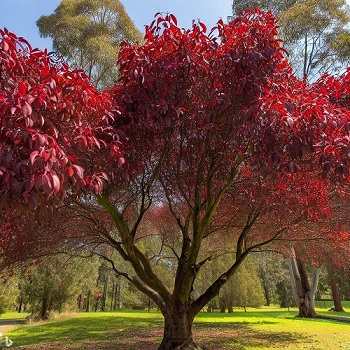
The black gum tree, also known as Nyssa sylvatica in botanical terms, is a beautiful deciduous tree that is common across Arkansas. The glossy green leaves of this medium-sized tree, which can grow to a height of 60 feet, change into a stunning display of reds, oranges, and purples in the autumn. The black gum tree attracts a lot of interest from nature lovers because it gives the autumnal landscape a mesmerizing splash of color.
The black gum tree’s glossy green leaves are on display throughout the growth season, adding to its all-around visual appeal. Nevertheless, this tree really shines in the entrancing autumn season. The leaves change dramatically, becoming a spectacular symphony of hues that includes flaming reds, dazzling oranges, and deep purples. The fall leaf show enhances Arkansas’s natural beauty and makes for a beautiful scene.
The black gum tree has a number of additional noteworthy qualities in addition to being attractive visually. Due to its medium stature and upright, thin growth habit, it adds a sophisticated touch to any landscape without dominating the surroundings. It’s also impressive how adaptable this tree is since it can grow well in a variety of soil types, including damp or poorly drained locations. The black gum tree is a flexible option for landscaping work in Arkansas because of its versatility.
The black gum tree is also a beneficial resource for animals, especially birds. The tree produces tiny fruits, often known as “gum balls” or “pepperidge balls,” which are a food source for many bird species. When food is in short supply, these fruits develop and mature in the autumn and winter and provide food for birds. The black gum tree supports ecological diversity and balance in Arkansas’s natural environment by attracting a variety of bird species.
2. White Oak
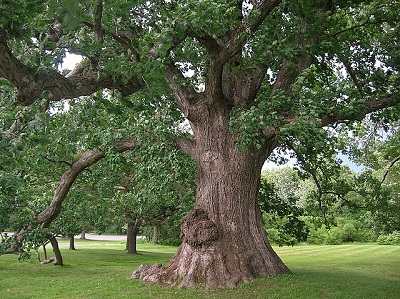
The white oak (Quercus alba), a majestic and resilient tree, adorns the woods and woodlands of Arkansas. For its priceless wood and capacity to provide a lot of shade, this unique species is highly valued. The white oak has an alluring look thanks to its deeply lobed leaves and characteristic grey bark. This tree not only adds to the scenic splendor of Arkansas, but it also significantly contributes to preserving the ecological balance of the area by acting as a vital source of food for local species.
The deeply lobbed leaves of the white oak are a distinguishing feature that makes it unique. Especially in the fall when they change into a vivid spectrum of warm yellows, rich browns, and burnt oranges, these delicately curved leaves provide an eye-catching show. This explosion of color gives the natural environment a hint of enchantment and enchants anybody who sees it.
Beyond its aesthetic value, the white oak is also important from an economic and ecological standpoint. This magnificent tree produces wood that is highly prized for its toughness, adaptability, and beauty. White oak wood is utilized in a range of industries for things like furniture, flooring, cabinets, and the creation of barrels for maturing premium wines and spirits. Its reputation as a remarkable species of wood attests to both its excellent quality and usefulness.
The significance of the white oak, however, goes beyond its financial worth. It is essential to preserving the fragile ecosystem’s equilibrium in Arkansas. Numerous animal species, such as squirrels, deer, turkeys, and other birds, depend on the acorns of the tree as a major source of food. These acorns ensure the survival of numerous animal species by providing sustenance during times of food scarcity. The white oak’s broad canopy and strong branches also provide shade and protection, forming a microhabitat that supports a variety of creatures. This microhabitat provides a safe sanctuary for smaller animals.
The endurance and tenacity of the white oak are astounding. These trees are able to endure the test of time and often live for many centuries. They represent strength and endurance in the natural landscape of Arkansas because of their capacity to adapt to a variety of environmental situations. They also capture the spirit of the area’s rich legacy.
3. Black Walnut
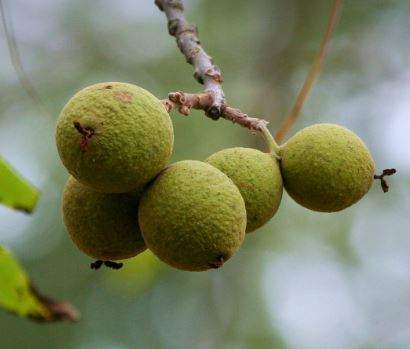
In Arkansas’s wide variety of trees, the black walnut tree, technically known as Juglans nigra, has a particular position. For its superb wood and the mouthwatering taste of its nuts, this wonderful deciduous tree is highly regarded. The black walnut is a large tree that may grow up to 100 feet tall, with complex leaves and tough, dark bark. The black walnut is widely regarded by both people and animals, especially for its highly sought-after wood, which is coveted in the furniture and flooring sectors.
The complex leaves of the black walnut tree are one of its distinguishing characteristics. During the tree’s growth season, these leaves, which are made up of numerous neatly distributed leaflets, provide a rich and attractive canopy. The black walnut’s elegant compound leaf structure enhances its natural attractiveness and helps it stand out in the environment of Arkansas.
The black walnut tree’s thick, dark bark adds to its textured, rough-hewn look. In addition to acting as a layer of protection, the highly wrinkled bark also acts as an identifying feature of the tree. It gives the black walnut a distinctive aesthetic aspect that distinguishes it from other tree species and increases its attractiveness.
Beyond its aesthetic value, the black walnut is significant. It is widely prized for its superb wood, which is in high demand in the flooring and furniture sectors. Because of its strength, toughness, and appealing grain patterns, black walnut wood is a popular choice for high-end furniture, cabinets, and other woodworking projects. Black walnut wood’s deep, rich tones provide any final product a feeling of richness and elegance.
The black walnut tree offers excellent culinary resources in addition to its wood, including its nuts. Black walnuts are a sought-after component in a variety of culinary dishes due to their distinctly rich and savory taste. Black walnuts provide food a distinctive and powerful taste whether they are added to baked goods, salads, or eaten as a snack. A large number of people and companies participate in the collecting and distribution of these highly sought nuts, which helps local economies.
In addition, the black walnut tree’s nuts are an essential component of the ecology since they provide food for many animals. The wholesome nuts are essential for squirrels, deer, and many other bird species, particularly during times when food may be in short supply. The black walnut tree’s contribution to the nutrition of animals highlights how crucial it is to maintaining Arkansas’ unique biological balance.
4. Flowering Dogwood

In Arkansas, the blooming dogwood (Cornus florida) is a true gem. The lovely blooms of this little deciduous tree, which bloom in the early spring and adorn the landscape with delicate hues of white, pink, and red, are its most well-known feature. The blooming dogwood’s attractiveness goes beyond its petals; with its unique bark and bunches of crimson berries, it maintains an eye-catching presence all year long. It is a prized and treasured tree in Arkansas since it not only enhances the surroundings but also feeds birds and other creatures.
The blossoming dogwood unfolds its hypnotic flowers as the seasons change from winter to spring, producing a display of unmatched beauty. Four-petaled, delicate flowers begin to bloom, coloring the landscape with their refined and subtle tones. The blooms, which cover the trees and lend a touch of magic to Arkansas’s rising landscape, vary in color from bright white to vivid pink and even deep crimson.
The blooming dogwood’s attractiveness goes beyond its blooms because of its eye-catching bark. The tree’s bark has an unusual pattern with a mixture of gray and brown tones. Due to its distinctive bark texture and hue, the blooming dogwood is immediately identifiable from a distance and adds visual appeal.
The crimson berry clusters on the blooming dogwood are another eye-catching characteristic. These berries, sometimes known as “dogwood fruit,” start to ripen in the late summer and continue into the autumn. The berries’ vivid red hue gives the tree a burst of brightness and further improves its aesthetic appeal. These berries are not only beautiful to look at, but they also provide birds and other creatures with essential nutrition. The vibrant berries attract a variety of bird species, aiding in their nutrition during migration or in times of food scarcity, and serve as an essential link in Arkansas’s biological web.
The blossoming dogwood maintains its allure year round, drawing viewers in throughout every season. This tree stands as a symbol of beauty and organic plenty, whether it is the magnificent blooms in the spring, the distinctive bark that provides texture and intrigue, or the clusters of crimson berries that offer brilliant color.
5. Tuliptree
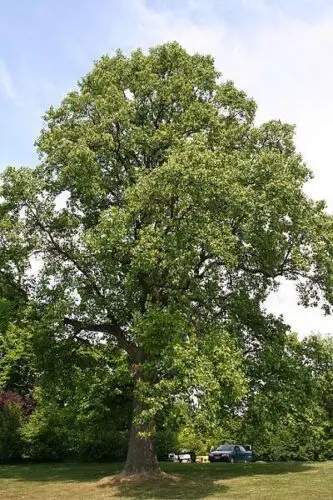
The majestic hardwood tree known as the tuliptree, or Liriodendron tulipifera in its scientific name, graces the landscapes of Arkansas with its magnificence. Despite its name, this famous tree is unrelated to tulips but yet serves as a symbol of unadulterated beauty in nature. The tuliptree draws attention with its straight trunk and striking tulip-shaped leaves, whether it towers over metropolitan vistas or adorns Arkansas’s woodland landscapes. This magnificent tree gets its name from its vivid yellow-green spring blossoms, which have a remarkable similarity to tulips. The tuliptree is revered for its wood, which is used to make furniture, veneer, and musical instruments, and it has a distinct position among Arkansas’s exceptional trees.
The strong trunk of the tuliptree, which grows straight and solid, adds to its towering majesty. This feature adds to the tree’s imposing size, which makes it a striking focal point in any environment. The tuliptree stands tall and strong, a symbol of natural grace and power, whether it is found in urban parks, providing a touch of elegance to cityscapes, or flourishes in the tranquil beauty of woods.
The tuliptree’s unusual tulip-shaped leaves are one of its distinguishing characteristics. These broad leaves have a distinctive four-lobed form that resembles the outline of a tulip blossom. During the growing season, the vivid green foliage grows into a thick canopy that offers shade and protection to the many plants and animals that seek refuge underneath it. The tuliptree’s leaves enhance its aesthetic appeal and exhibit an attractive shape that sets it apart from other tree species.
The tuliptree adorns the environment with a stunning display of yellow-green blossoms in the spring. The emergence of these blooms, which are tulip-like in appearance and color and grow at the apex of the branches, makes for an amazing sight. The colorful blossoms sustain the fragile web of life in Arkansas and bring color to the surroundings while also providing nectar for pollinators like bees and butterflies, which helps to maintain ecological equilibrium.
The tuliptree has substantial value for its wood in addition to its aesthetic appeal. Because of its adaptability, durability, and aesthetic value, tuliptree wood is highly regarded. It is often used to build furniture, where the pieces are given a touch of natural beauty by the straight grain and light hue. Additionally, veneer applications using the wood are popular because they provide a beautiful finish to paneling and cabinets. The excellent properties of tuliptree wood have even led to its popularity as a material for musical instruments, demonstrating its adaptability and adding to Arkansas’s cultural history.
6. Loblolly Pine
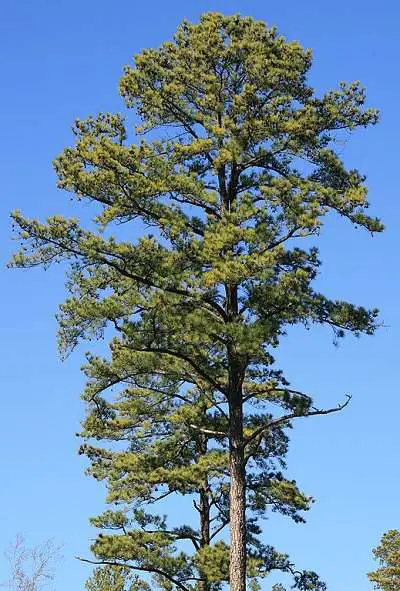
The loblolly pine (Pinus taeda), a well-known and noticeable tree, is present in all of Arkansas’s forested areas. It has a key place in the environment of the state since it is an evergreen conifer. The loblolly pine is well-known for its quick growth and economic usefulness. It has long needles grouped in threes, and its reddish-brown bark is unusual. In addition to being beautiful, it plays a key role in supplying habitat and wood supplies for a wide variety of species, making it an important part of Arkansas’s natural ecosystem.
The amazing growth rate of the loblolly pine is one of its distinguishing features. This species has a remarkable capacity for rapid growth, which has enabled it to flourish and establish itself as one of the dominant tree species in Arkansas. As the loblolly pine reaches maturity, it may grow to significant heights and create thick stands, sculpting the landscape and leaving a lasting imprint on the woods of Arkansas. Its capacity to thrive in many habitats and adapt to a variety of soil conditions is another factor in its widespread occurrence.
The long needles of the loblolly pine, which grow in bundles of three, are what make them distinctive. Given that the tree is evergreen, these needles may go as long as several inches and keep their brilliant green color all year long. These needles let the loblolly pine conduct photosynthesis, which helps maintain its general health and vitality while also enhancing its visual appeal and allowing it to turn sunlight into energy.
The reddish-brown bark of the loblolly pine is another eye-catching characteristic. The bark of the tree becomes deeply furrowed and ridged as it ages, giving it a rough, textured look. Beyond just being attractive to look at, the bark protects the tree from the weather and gives it resiliency in the face of environmental problems.
It is impossible to overestimate the loblolly pine’s importance to the environment. Numerous animal species find a suitable home and nesting locations under its deep canopy and profusion of vegetation. The loblolly pine’s branches and leaves provide a haven for birds, squirrels, and other small animals, all of which are a part of the complex web of life in Arkansas’s woods.
The loblolly pine also has significant economic significance. building, furniture making, paper production, and the building of utility poles are just a few of the many uses for this highly sought-after wood. The loblolly pine is a vital resource that supports the economy and industry of Arkansas thanks to its straight trunks, wide availability, and attractive wood characteristics.
7. Dawn Redwood

The dawn redwood (Metasequoia glyptostroboides) is an alluring and distinctive tree that serves as a living fossil and transports us back in time. This magnificent deciduous evergreen, once thought to be extinct, was found in China in the 1940s, stunning and enthralling botanists and nature lovers around. The dawn redwood adds a touch of elegance and beauty to its surroundings with its cinnamon-colored bark and feathery, fern-like leaves. In Arkansas, where it provides a touch of historical importance and natural beauty to landscaping projects, its propensity to grow in a range of soil types has made it a popular option.
The dawn redwood’s status as a living fossil is very amazing. Its finding in the far-flung areas of China towards the middle of the 20th century shocked the scientific world since it was formerly believed to have gone from the Earth. This old tree is a fascinating link to prehistoric periods, acting as a living link to the distant past and providing a glimpse into the world as it was millions of years ago.
The dawn redwood’s greenery adds to its charm. It has an unusual and ethereal look due to its delicate, feathery leaves that resemble fern fronds. Particularly in the spring and summer, the vibrant green of the vegetation adds a revitalizing vigor to its surrounds. The foliage of the morning redwood changes dramatically over the course of the year, becoming golden bronze before elegantly falling off and covering the ground in a patchwork of deep autumnal colors.
The dawn redwood’s cinnamon-colored bark is quite beautiful. It has a unique texture that gives the tree’s trunk and branches more visual appeal. The tree’s surface is rough and textured due to the peeling and flaking bark, which adds to the tree’s appeal overall and attests to its durability and endurance over time.
The dawn redwood’s capacity to adapt to many soil types is one of its noteworthy characteristics. It is a flexible option for landscaping work in Arkansas since it does well in both damp and well-drained soils. The dawn redwood provides a touch of mystery and beauty to gardens, parks, or other natural settings, blending in with the surroundings and highlighting the area’s history and natural grandeur.
In addition, Arkansas’s naturalists and landscape designers like the dawn redwood because of its unique qualities and historical importance. Its adaptability to various soil types and alluring look have made gardens, parks, and other outdoor areas common destinations for it. The morning redwood’s presence not only improves the aesthetics but also acts as a tangible reminder of the wonders of nature and the value of conservation and preservation.
8. Cedar Elm
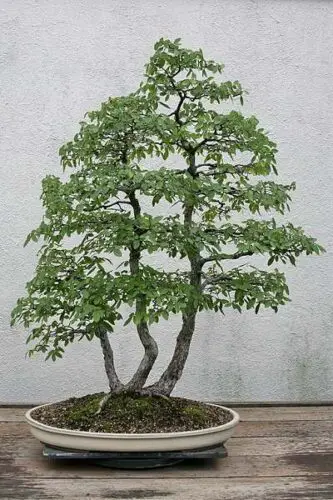
Arkansas’s woods and bottomlands are home to the medium-sized cedar elm (Ulmus crassifolia), a deciduous tree. The narrow, serrated leaves and rough, grey bark of this tree give it a unique look that makes it stand out. The capacity of the cedar elm to adapt to various soil types and its tenacity in the face of drought make it even more impressive. As a consequence, it contributes significantly to preserving Arkansas’s biodiversity by providing a home and habitat for many animals, such as birds and butterflies.
The cedar elm has a distinctive appearance because to its rough, grey bark. This bark’s rough surface not only improves its aesthetic appeal but also acts as a barrier against the weather. The bark of the tree develops in prominence as it ages, giving it a hardy surface that contributes to its allure.
The cedar elm’s tiny, serrated leaves are another distinguishing characteristic. The delicate and ragged margins of these leaves add to the tree’s unique look. The vivid canopy that develops throughout the growing season from the lush green foliage shades the area and fosters a serene ambiance.
The cedar elm’s capacity to adapt to many soil types is one of its amazing traits. It exhibits its adaptability by thriving in a variety of soil types, from bottomlands to uplands. The cedar elm exhibits its capacity to adapt and flourish, making it well-suited for varied settings in Arkansas, whether the soil is well-drained or more moisture-rich.
Along with flexibility, the cedar elm has remarkable drought resistance. It can continue to thrive and keep its vitality even when there is little rain. The cedar elm contributes significantly to Arkansas’s scenery, especially in areas where water may be in little supply, thanks to its tolerance to dry circumstances. The state’s natural ecosystem is more stable and ecologically balanced because of its capacity to resist drought.
In addition to their beauty and toughness, cedar elms provide important habitat and shelter for animals. Other little species, including butterflies and birds, find shelter amid its branches and vegetation. For these critters, the thick canopy and foliage give shelter, breeding grounds, and a secure sanctuary. The cedar elm’s function as a wildlife habitat enhances Arkansas’s total biodiversity and supports the complex web of life that exists within its ecosystems.
9. Baldcypress
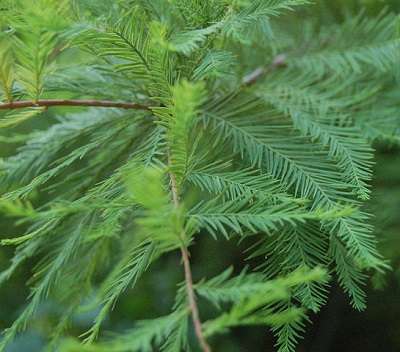
The baldcypress (Taxodium distichum), a tree that dominates the marshes and swamps of Arkansas, is a national symbol. This fascinating plant mesmerizes the senses with its distinctive fluted stem and fluffy light green leaves. The baldcypress, which thrives in swampy areas and is vital to maintaining the delicate balance of Arkansas’s many ecosystems by acting as a home for a wide variety of animal species, protects the state’s waterlogged surroundings.
A noteworthy feature that sets the baldcypress apart from other trees is its fluted trunk. Its trunk has a distinctive, sculptural look due to a succession of vertical ridges and indentations. The tree’s distinctive fluting improves structural stability and provides aesthetic beauty while also enabling it to endure the difficulties posed by its wet environment.
The baldcypress’s slender branches and fluffy light green leaves complement its stunning stem. Soft, needle-like leaves make up the foliage, which grows under a thick canopy. The bright green hue of the leaf creates a dramatic contrast against the background of the wetlands’ shadowy, enigmatic waters, adding to the tree’s overall aesthetic attraction.
The baldcypress plays a crucial role in Arkansas’s marshes and swamps because it has evolved to flourish in damp settings. Its amazing adaptation and durability are on display by its capacity to endure protracted floods. The baldcypress thrives in these particular settings and offers a variety of animal species with food, shelter, and nesting locations. Within its branches, birds, reptiles, amphibians, and mammals find shelter, while ducks, squirrels, and other creatures eat its seeds and cones as a vital source of food. The baldcypress plays a key role in the state’s overall biodiversity and ecological balance in wetland areas.
The baldcypress is also very important for maintaining the quality of the water. Its vast root system aids with soil stabilization, avoiding soil erosion and minimizing sediment and pollution discharge into streams. The tree’s capacity to soak up more water also contributes to flood mitigation by serving as a natural barrier against flooding occurrences and reducing the effect on nearby communities.
10. Black Cherry

Arkansas’s woods and forests are home to the spectacular deciduous black cherry (Prunus serotina). This tree has a distinct charm and is renowned for its dark, fragrant bark as well as its clusters of white blooms. Although its fruits may taste unpleasant to humans, many animals appreciate them much and often turn them into delectable jams and jellies, demonstrating their adaptability and importance.
The dark and fragrant bark of the black cherry distinguishes it from other trees. The tree’s attractive bark provides a stark contrast to the greenery around it, ranging in hue from deep brown to almost black. Along with being attractive, the tree’s bark also has a nice scent that adds to the sensory experience of coming into contact with it. Additionally, the bark acts as a barrier, protecting the tree from the elements and enhancing its toughness and endurance.
The black cherry dresses itself in clusters of exquisite white blooms in the spring. These flowers enhance the landscape’s splendor by producing a mesmerizing display of pure white against the forest’s background. Additionally, the blossoms give off a delicate and alluring aroma that draws in pollinators like bees and butterflies. By making pollen transmission easier, their presence promotes the tree’s reproduction and helps keep Arkansas’s biodiversity alive.
Although the black cherry’s fruits have a bitter flavor to humans, animals finds immense value in them. Many animals gladly eat the cherry for their nutritious meat, including birds, squirrels, and deer. These species rely on the fruits as a crucial source of nutrients for their life and general well-being. In addition, animal eating of the cherries aids in seed dissemination, which promotes the growth of the black cherry and aids in forest regeneration.
The cherries picked from the black cherry tree have human applications in addition to being attractive to animals. To make delicious jams, jellies, and pies, the bitter flavor of the fruits may be altered using a variety of techniques, such as heating and sweetening. These culinary dishes emphasize the black cherry’s adaptability and show how useful it is to use its fruits in many ways.
According to ecology, the black cherry tree offers a range of animal species with vital habitat and protection. Its thick foliage provides shelter and safety, acting as a haven for activities like breeding, roosting, and foraging. Black cherry trees are important in preserving the delicate balance of ecosystems and to the general health and variety of Arkansas’s woods and forests.
11. Willow Oak
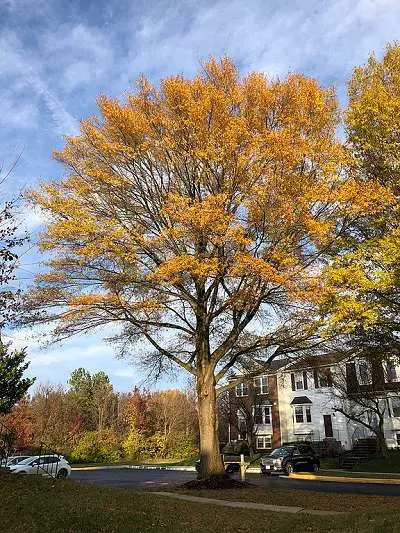
The elegant willow oak (Quercus phellos) adorns Arkansas with delicate leaves that resemble willow branches. The bottomlands and wet places are where you’ll often find this medium- to large-sized deciduous tree. The leaves of the willow oak become a lovely shade of yellow or golden brown in the autumn, providing an amazing spectacle. It is a significant contributor to the ecology since its acorns provide animals with essential food.
12. American Elm
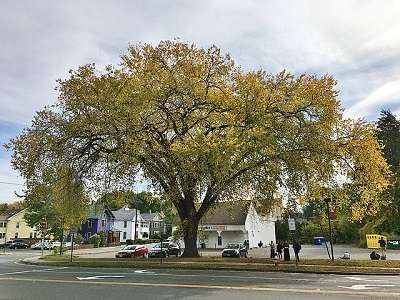
The American elm (Ulmus americana), which was formerly a noticeable element of Arkansas landscapes, has had considerable difficulties as a result of Dutch elm disease. But this magnificent tree, with its soaring branches and elliptical leaves, continues to inspire awe in our hearts. The wood of the American elm is still highly prized for its hardness and durability, despite attempts to conserve and protect the surviving specimens.
13. Water Oak
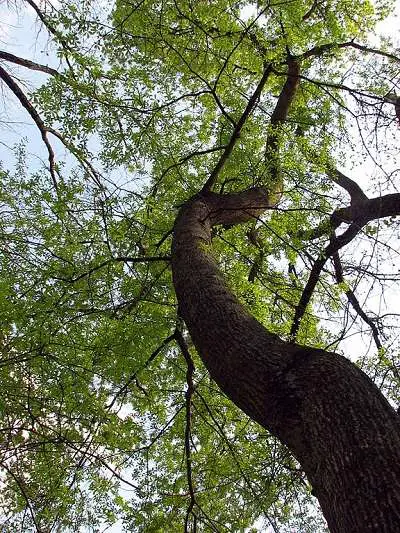
The water oak (Quercus nigra) is a deciduous tree that grows quickly and is adaptable to a variety of soil types. Its distinctive leaves, which have rounded lobes and teeth with bristles, provide a delicate canopy of greenery. Despite its name, the water oak can grow in upland places as well and doesn’t need a lot of moisture. The water oak is an important component of Arkansas’ natural ecology because it offers food and habitat to many animal species, including birds and squirrels.
14. American Holly
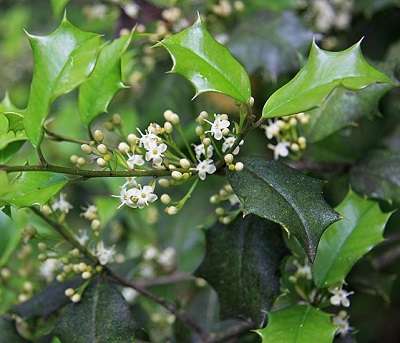
The American holly (Ilex opaca) gives Arkansas a festive feel and winter splendor. This evergreen tree is graceful with its glossy, dark green foliage and vivid red berries. The American holly, which is the official tree of Arkansas, is known for its unique bark and bright red berries, which provide year-round aesthetic appeal and are an important source of food for birds and other species.
15. Redbud
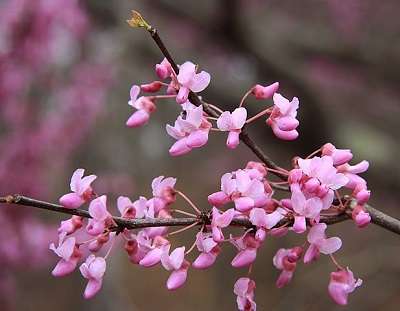
The redbud (Cercis canadensis) decorates Arkansas in the early spring with its beautiful flashes of pink and purple. This little to medium-sized deciduous tree is well-known for its beautiful blooms, which appear before the leaves do. The redbud’s heart-shaped leaves, which turn a vivid yellow in the autumn, continue to give aesthetic appeal throughout the year. It is a widely used ornamental tree that is essential in delivering nectar for insects.
16. Hackberry
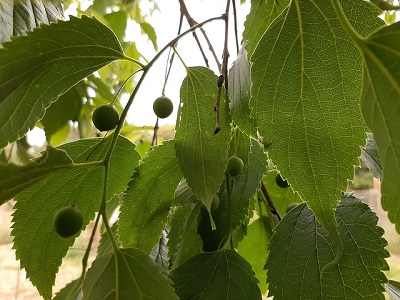
The hackberry tree (Celtis occidentalis) is a hardy and flexible plant that may thrive in a variety of growth environments. Its asymmetrical leaves and rough, warty bark give it a distinctive look. Birds and other species use the tiny, purple fruits of the hackberry as a food source. The hackberry is recognized for its capacity to provide shade in urban settings and is often utilized in reforestation projects.
17. Chestnut Oak

The chestnut oak (Quercus montana), as its name indicates, yields acorns that resemble the nuts of chestnut trees. Throughout Arkansas, highland regions and rocky slopes are home to this medium- to large-sized deciduous tree. The deep-lobed leaves and grey bark of the chestnut oak provide its surroundings an attractive appeal. The chestnut oak, prized for its tough wood, is used in building and furniture production.
18. Overcup Oak

The overcup oak (Quercus lyrata) is a distinctive tree species that thrives in wetland habitats. Its acorns have a “overcupped” look because a cap partly encloses them. The overcup oak, with its glossy, leathery leaves and light gray bark, provides habitat and food for a variety of aquatic and terrestrial creatures. Its presence increases Arkansas’s biodiversity.
19. Persimmon Tree
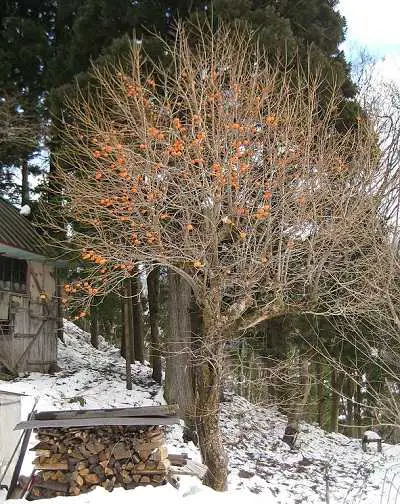
Arkansas enjoys the tiny, orange fruits of the persimmon tree (Diospyros virginiana), which mature in the late summer and early autumn. Both people and animals like these sweet and tasty fruits. The persimmon tree is tolerant of several soil types and does well in both upland and bottomland regions of Arkansas. The persimmon tree’s strong, solid wood is used to make furniture and golf club heads in addition to its fruit.
20. Kentucky Coffeetree
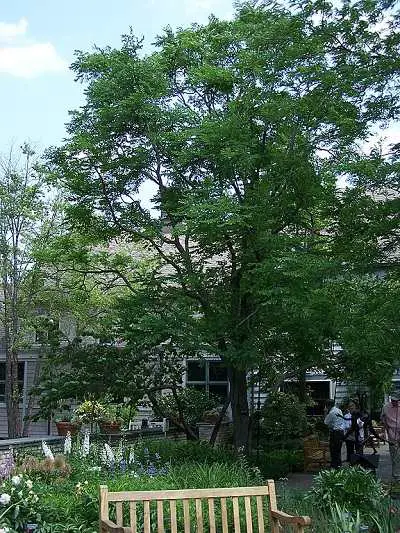
In Arkansas, the Kentucky coffeetree (Gymnocladus dioicus) is a distinctive and eye-catching tree species. It draws notice with its thick, complex leaves and rough, scaly bark. The Kentucky coffeetree does not really produce coffee beans, despite its name. It was historically significant, nonetheless, as a replacement for coffee in times of shortage. The Kentucky coffeetree adds to the urban and rural landscapes of Arkansas and is highly prized for its capacity to provide shade and flourish in urban environments.
21. Bur Oak
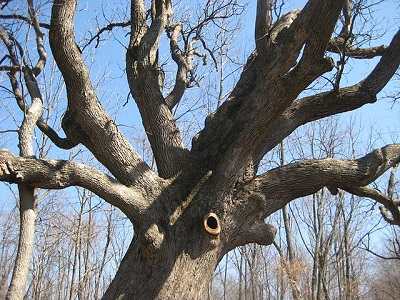
In Arkansas’s forests and grasslands, the bur oak (Quercus macrocarpa), a towering tree, draws attention. It has a special attractiveness due to its huge, deeply lobed leaves and corky bark. The bur oak’s timber is highly prized for its hardness and durability, and its acorns offer food for animals. The bur oak is an imposing representation of perseverance due to its toughness and capacity to survive challenging climatic conditions.
22. Shumard Oak
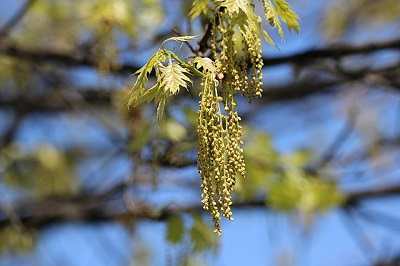
The Shumard oak (Quercus shumardii), which bears Benjamin Franklin Shumard’s name, is a model of beauty and adaptability. With its highly lobed leaves and reddish-brown bark, it gives the landscape of Arkansas a striking appearance. Shumard oaks are valuable sources of wood for furniture, flooring, and cabinetry, and their acorns are essential to the survival of animals.
23. Swamp Chestnut Oak
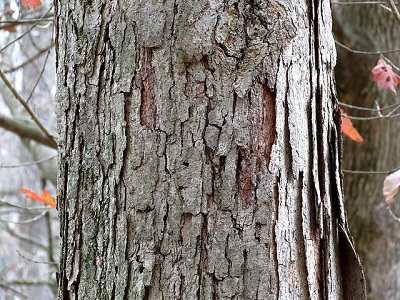
The marshy or wet conditions of Arkansas are ideal for the swamp chestnut oak (Quercus michauxii). Its leathery leaves have definite serrated borders and stay a deep green hue all year long. Numerous animals, such as ducks and deer, depend on the acorns of the swamp chestnut oak for sustenance. It is used to make fence posts and railroad ties because of its sturdy wood.
24. Blackjack Oak
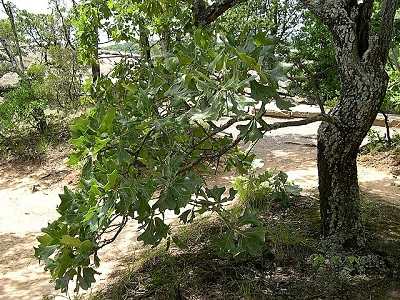
A small to medium-sized deciduous tree that adapts well to dry and sandy soils is the blackjack oak (Quercus marilandica). Blackjack oak leaves have a distinctive form that makes them easy to identify and its dark, almost black bark makes it stand out. Even though it is a little tree, it is very important for Arkansas’ animals to have shelter and food because of this tree.
25. Eastern Red Cedar
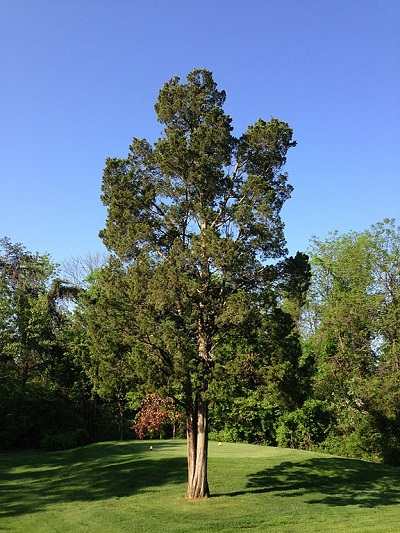
A hardy and fragrant evergreen tree that grows abundantly across Arkansas is the eastern red cedar (Juniperus virginiana). It provides a touch of greenery to the environment all year long with its thick foliage, which is made up of leaves that resemble scales. Birds depend on the blue-gray berries of the eastern red cedar as a major source of food, and its wood is highly prized for its toughness and insect resistance.
26. Osage Orange

The hedge apple or bois d’arc, also known as the osage orange (Maclura pomifera), has a striking look. It is simple to identify because to its thorny branches and huge, grapefruit-sized fruits. Although the fruits are not often ingested by people, they are occasionally utilized as natural insect repellents because of their ability to ward off particular pests. Fence posts and bows are both made from the osage orange’s solid, long-lasting wood.
27. Southern Red Oak
The southern red oak, or Quercus falcata, is a regal tree that grows to magnificent heights. Its leaves have a distinctive form with deep lobes and teeth with bristles at the tips. The southern red oak’s acorns support a variety of fauna, and its wood is used to make flooring, furniture, and cabinets.
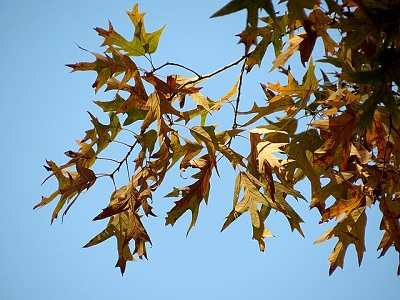
28. Red Maple

In all of Arkansas, the red maple (Acer rubrum) demonstrates how adaptable and versatile it is. The red maple makes for a spectacular sight in the autumn when its vivid colours of orange, red, and gold are on show. While its wood is used to make flooring and furniture, the red maple’s sap is often gathered and turned into maple syrup. The tree also serves as a home for tiny animals and birds.
29. Chinkapin Oak
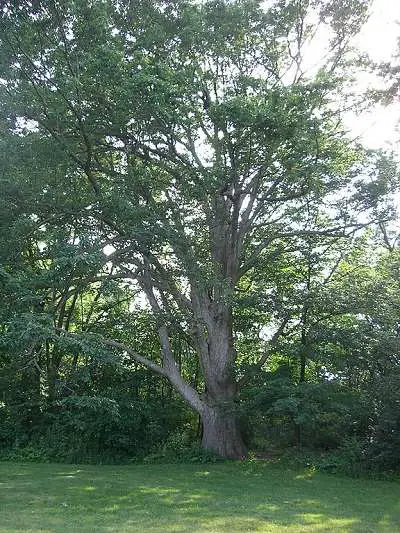
One notable medium-sized native Arkansas deciduous tree is the chinkapin oak (Quercus muehlenbergii). It beautifies the environment with its deeply lobed leaves and light gray bark. The acorns of the chinkapin oak offer food for animals, and its wood is highly prized for its toughness and endurance. It often grows in highland locations and provides useful shade in both urban and rural settings.
30. Dogwood

Arkansans have a particular place in their hearts for the dogwood (Cornus spp.), which is cherished for its decorative value and exquisite flowers. The dogwood’s recognizable blossoms, which come in white, pink, and red hues, bloom in the spring and provide an eye-catching show. These tiny to medium-sized trees also provide bright red berries that attract animals like birds. In Arkansas, the dogwood serves as a metaphor for beauty and tenacity.
31. Sugar Maple
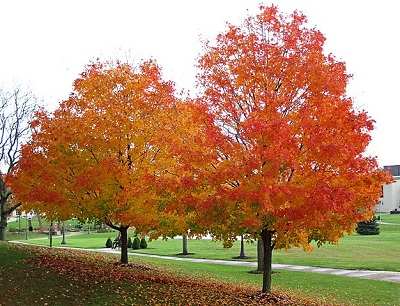
The sugar maple, or Acer saccharum, is a towering tree that reaches tall and is well-known for its stunning autumn leaves. As its leaves change into vivid hues of orange, red, and gold, they turn into a breathtakingly beautiful landscape picture of Arkansas. The wood of the sugar maple is treasured for its strength and used to make furniture and flooring, while its sap is gathered and converted into maple syrup.
32. Sweetgum
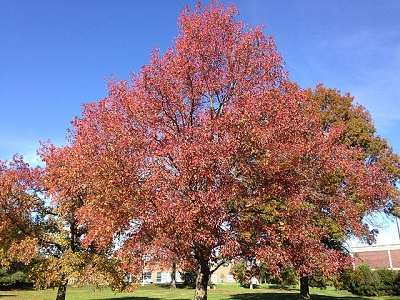
In all of Arkansas, the sweetgum tree (Liquidambar styraciflua) displays its beauty and practicality. It creates a lasting impact with its star-shaped leaves and long thorns on the branches. While not commonly eaten by humans, the flat, brown “gumballs” that the tree produces are prized by animals. The wood of the sweetgum is used for veneer, furniture, and cabinets.
33. Post Oak
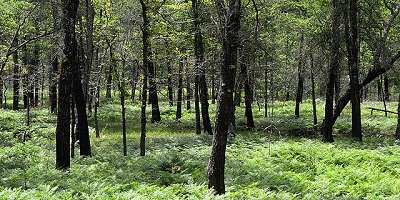
In uplands and wooded areas across Arkansas, the post oak (Quercus stellata) is a hardy and drought-tolerant tree. The post oak enhances the aesthetic appeal of its surroundings with its unusually shaped leaves and gray to brown bark. The solid wood of the tree is resistant to rust and decay, making it a popular option for railroad ties and fence posts.
34. American Sycamore
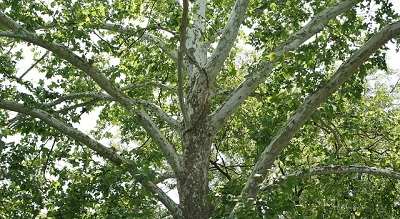
The American sycamore (Platanus occidentalis) is a huge, imposing tree that is distinguished by its spotted bark and broad, lobed leaves. The American sycamore, which grows in marsh and riverbank locations, enhances the beauty of the Arkansas countryside. Its wood is used in building and furniture manufacture, and its white, flaky bark offers year-round aesthetic attractiveness.
35. Shortleaf Pine
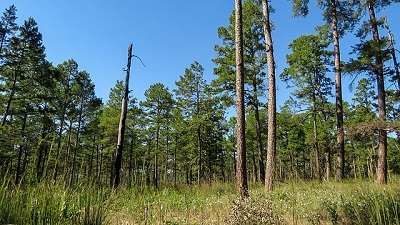
As an important tree species with both economic and ecological value, the shortleaf pine (Pinus echinata) has special significance in Arkansas. This evergreen conifer has reddish-brown bark and long needles grouped in bundles of two to three. The shortleaf pine is a significant supplier of lumber, pulpwood, and resin and plays a significant role in providing habitat for animals.
36. Pecan Tree
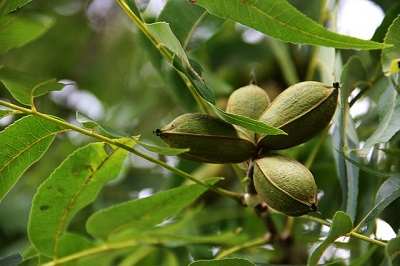
The pecan tree (Carya illinoinensis), which is famous for producing tasty pecans, is the source of these nutty nuts. A wide, spreading canopy and compound leaves are features of this huge deciduous tree. Pecan trees are highly prized for their contributions to the economy and the environment. Pecan trees provide shade, wood, and habitat for animals in addition to their nuts.
37. Winged Elm
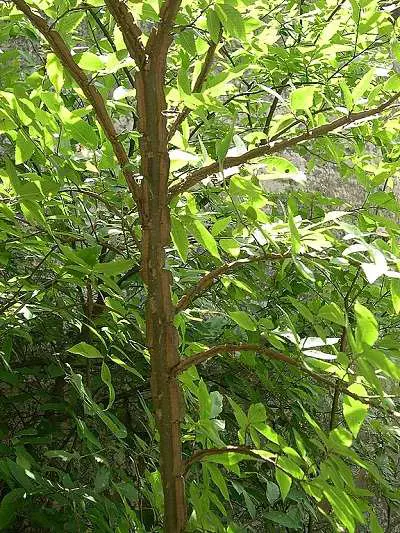
Arkansas is home to the winged elm (Ulmus alata), a small to medium-sized deciduous tree. The corky “wings” that develop along the branches, giving the tree an intriguing texture, are its defining characteristic. The winged elm has asymmetrical, serrated leaves, and gray to brown-colored bark. This tree exhibits resistance to Dutch elm disease and does well in a variety of soil types.
38. Honey Locust
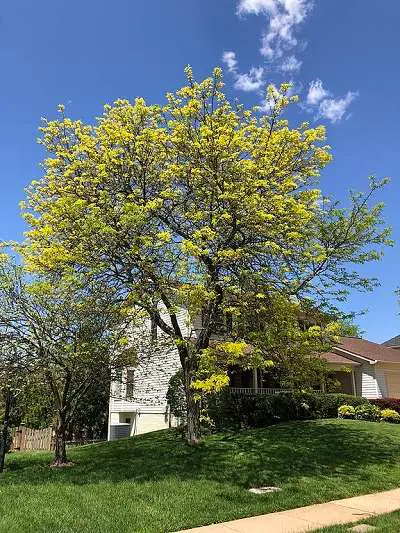
The honey locust (Gleditsia triacanthos) is a beautiful and practical tree. The honey locust is stunning with its long thorns on the branches and delicate, fern-like leaves. Wildlife like the flat, brown pods produced by the tree because they contain a tasty, gooey content. The honey locust is highly prized for its sturdy and long-lasting wood, which is used for flooring, furniture, and fence posts.
39. Eastern Redbud
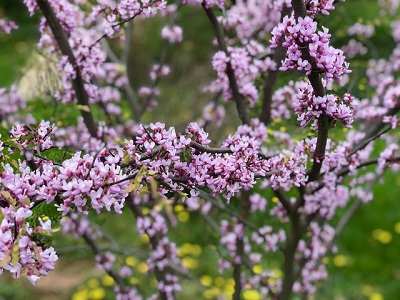
In the early spring, the eastern redbud (Cercis canadensis) adorns Arkansas with its exquisite displays of pink and purple. This little to medium-sized deciduous tree is well-known for its beautiful blooms, which appear before the leaves do. The eastern redbud’s heart-shaped leaves give visual appeal all year long and become a vivid yellow in the autumn. It is a widely used ornamental tree that is essential in delivering nectar for insects.
40. Southern Magnolia
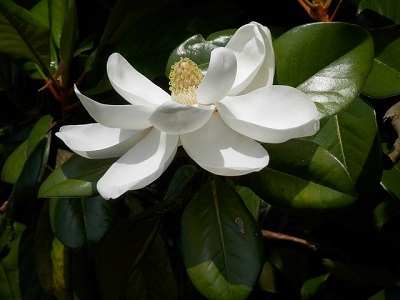
The southern magnolia (Magnolia grandiflora), a symbol of the South, is last but by no means least. With its tall, glossy foliage and fragrant, white blossoms, this evergreen tree gives a touch of elegance to the scenery of Arkansas. Southern magnolias are renowned ornamental trees because to their exquisite blossoms and elegant shape, which have earned them the distinction of becoming Arkansas’ official state tree flower. Its seeds serve as food for tiny animals and birds, while its wood is used to make furniture.
We have now completed our tour of the 40 most prevalent trees in Arkansas, and we have seen firsthand the state’s astounding variety and alluring beauty. Each tree, from the tall pines to the delicate dogwoods, has an own tale to tell and is essential to the rich fabric of Arkansas’s natural environment. Consider for a minute the natural beauties that exist in our beautiful Arkansas the next time you find yourself surrounded by the beauty of these trees.
Related Posts:
